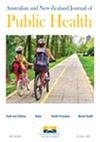在Tāmaki马科劳,较高的人口密度与较差的空气质量和相关的健康结果有关。
IF 2.4
3区 医学
Q2 PUBLIC, ENVIRONMENTAL & OCCUPATIONAL HEALTH
Australian and New Zealand Journal of Public Health
Pub Date : 2025-02-01
DOI:10.1016/j.anzjph.2024.100213
引用次数: 0
摘要
目的:探讨新西兰奥克兰市Tāmaki马科劳地区人口密度、空气污染浓度和相关健康结果之间的关系。方法:从2016年新西兰健康与空气污染研究中获得二氧化氮(NO2)和细颗粒物(PM2.5)的浓度和相关的健康结果(过早死亡、心血管和呼吸系统住院以及儿童哮喘)。评估的可能中介因素是机动车交通、家庭火灾、当地工业和绿地。结果:人口密度越大,NO2 (β: 0.18, p < 0.01)和PM2.5 (β: 0.04, p < 0.01)浓度越高。与PM2.5暴露相关的二氧化氮和呼吸道住院相关的不良健康结果随着城市地区密度的增加而增加。影响最大的中介因子是机动车交通。结论:奥克兰较高的人口密度与较差的空气质量和相关的健康结果有关。机动车交通是最重要的污染源,在城市人口最密集的地区污染程度最高。对公众健康的影响:除非采取措施减少机动车排放物的暴露,否则奥克兰住房密集化可能会增加空气污染造成的健康不良。本文章由计算机程序翻译,如有差异,请以英文原文为准。
Higher population density is associated with worse air quality and related health outcomes in Tāmaki Makaurau
Objectives
To explore associations between population density, air pollution concentrations, and related health outcomes in Tāmaki Makaurau Auckland, Aotearoa New Zealand.
Methods
Concentrations of nitrogen dioxide (NO2) and fine particulate matter (PM2.5) and associated health outcomes (premature mortality, cardiovascular and respiratory hospitalisations, and childhood asthma) were obtained from the Health and Air Pollution in New Zealand 2016 study. The possible mediating factors assessed were motor vehicle traffic, domestic fires, local industry, and green space.
Results
Higher population density was associated with higher concentrations of NO2 (β: 0.18, p < 0.01) and PM2.5 (β: 0.04, p < 0.01). Adverse health outcomes related to NO2 and respiratory hospitalisations attributed to PM2.5 exposure increased incrementally with the density of urban areas. The mediating factor with the strongest effect was motor vehicle traffic.
Conclusions
Higher population density in Auckland is associated with worse air quality and related health outcomes. Motor vehicle traffic is the most important source of pollution and is highest in the most densely populated parts of the city.
Implications for Public Health
Housing intensification in Auckland will likely increase ill health from air pollution unless steps are taken to reduce exposure to emissions from motor vehicles.
求助全文
通过发布文献求助,成功后即可免费获取论文全文。
去求助
来源期刊

Australian and New Zealand Journal of Public Health
医学-公共卫生、环境卫生与职业卫生
CiteScore
4.20
自引率
5.70%
发文量
121
审稿时长
6-12 weeks
期刊介绍:
The Australian and New Zealand Journal of Public Health (ANZJPH) is concerned with public health issues. The research reported includes formal epidemiological inquiries into the correlates and causes of diseases and health-related behaviour, analyses of public policy affecting health and disease, and detailed studies of the cultures and social structures within which health and illness exist. The Journal is multidisciplinary and aims to publish methodologically sound research from any of the academic disciplines that constitute public health.
 求助内容:
求助内容: 应助结果提醒方式:
应助结果提醒方式:


